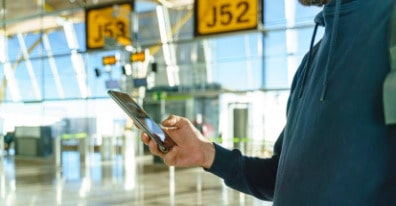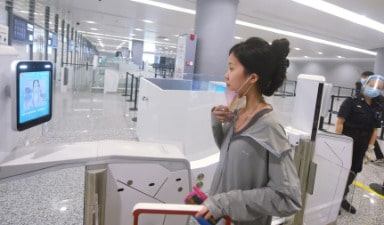
With Spring Break around the corner, travelers are expected to flock to airports in droves similar to pre-pandemic rates. For many of those travelers, it’s likely they will encounter biometric technology to verify their identity at security checkpoints. Without having to scan their boarding pass, an image of their face can verify that they’re the traveler they claim to be. In states like Arizona, Ohio, or Colorado, travelers may also be able to use a digital ID, allowing them to present a digital form of identity to breeze through baggage checks and security lines.
Biometric and decentralized identity technology, like facial recognition and digital wallets, has begun proliferating across the travel industry to streamline traveler experiences and ensure greater security. And there’s a lot enterprises can learn from it—from scalability to education to adoption.
Creating a smooth, secure experience
Lesson #1: Simplicity drives adoption
One reason biometric identity verification and digital wallet technology have been well received by travelers is their ease of use, which makes the travel experience both faster and more secure. Making adoption worth customers’ time and energy is paramount.
According to recent data, travelers strongly support the Transportation Security Administration’s (TSA) use of biometrics at airport security checkpoints and agree that identity verification is important for security:
- 90% of air travelers say they would be more likely or equally likely to support biometric use at TSA security checkpoints if it reduced the typical time it takes them to get through security by 5 to 15 minutes.
- The majority of American air travelers (78%) support the use of biometrics at TSA security checkpoints to confirm the identity of travelers.
- Nearly all Americans (92%) agree that verifying traveler identity is an important measure taken by TSA to protect the flying public.
What enterprises should take away:
Customers care about ease of use. For example, in the case of passwords, 54 percent of consumers say they have stopped using an account or online service because they became frustrated when trying to log in.
Therefore, anything enterprises can do to remove friction from the customer experience will go a long way in creating more secure, seamless digital interactions and boosting trust. It’s not enough to simply promise customers that their data will be secure. It’s also important to make sure you’re making it as easy as possible for them to adopt a new way of operating.
Investing in scalability through education and collaboration
Lesson #2: Gradual rollout and consumer buy-in are key
If airport biometric technology rollouts have demonstrated anything, it’s that biometric and decentralized identity technology is scalable and can be implemented widely with the right collaboration, education, and consumer buy-in.
Forms of biometric technology across airport security have been around since the early 2000s, but it wasn’t until around 2019 that TSA began to roll out facial recognition technology to verify passengers. Initially piloted in major cities like Atlanta and Los Angeles, there are now over 230 airports that actively use biometric technology and digital IDs to create a smooth, secure travel experience—with a goal of expanding beyond 400.
TSA worked closely with airlines, employees, and travelers to ensure communication of its implementation was clear and provided resources for travelers to learn more about how their data would be used.
What enterprises should take away:
The successful expansion of this technology across the country has shown that widespread adoption is not only possible but can thrive when introduced gradually and with clear education.
For enterprises looking to scale, transparency and education should be at the forefront of adoption strategies. Providing customers with step-by-step guidance, FAQs, and clear demonstrations of security measures will help build confidence. Additionally, partnering with trusted organizations and early adopters can validate credibility and make transitions smoother.
Guaranteeing privacy and granting autonomy
Lesson #3: Transparency is non-negotiable
One of the biggest hurdles to adopting biometric and decentralized identity technology is users’ fear or lack of understanding regarding how their personal data will be used. Enterprises must ensure users’ privacy and grant them autonomy over their data.
TSA has always been clear with travelers that their biometric data is not used for surveillance and that data is deleted after verification. Travelers also have the option to opt out of participation with zero negative consequences. They have the right to decline a photo being taken and may opt for an alternative mode of verification.
What enterprises should take away:
When asking customers to share sensitive personal data, such as biometric data, organizations must emphasize security and privacy while giving users control over their information.
Decentralized identity solutions, which enable customers to manage their own identity credentials and choose how much data to share in a given interaction, can help build trust. Organizations should:
- Clearly communicate how personal data is stored, used, and deleted.
- Provide opt-out options without penalizing users.
- Implement and highlight security measures like encryption and multi-factor authentication.
Embracing innovation
The rollout of biometric technology and digital wallets is still taking shape across both domestic and international travel, but there are valuable lessons to be learned along the way for enterprises looking to implement similar technology.
It can often be daunting for organizations to embrace new technology that modernizes their current practices, but doing so allows them to move forward with greater customer trust, security, and loyalty.
Airports have taken the leap and are leading the charge in biometric and decentralized identity technology, proving that embracing innovation can lead to more seamless, secure experiences. Businesses across industries should take note and embrace that same spirit of innovation while staying adaptable, secure, and customer-focused.
Article: Smooth travels: How airports are paving the way for widespread biometric technology adoption


